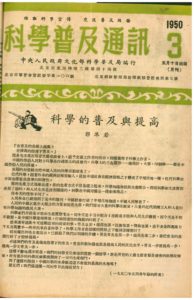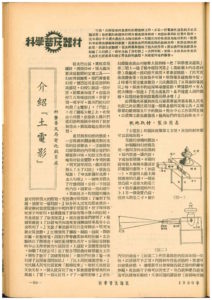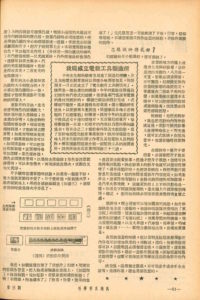Bringing Movies to the Countryside (1950)
Bringing Movies to the Countryside (1950)
The use of cinema in China was a powerful weapon of propaganda in the modernization process in 20th century China. A true breakthrough occurred in the year 1949 when film production and distribution came under state control, with politics and art closely intertwined.
In fact, the CCP’s interest and penetration into the movie industry had already started during its conflict with Japan and KMT. After the Communist triumph in mainland China, the whole industry was soon under the complete control of the Party. Not only did the CCP establish the strict centralized administration of cinema, the newborn regime also imposed direct management on both movie production process and distribution-exhibition affairs. On top of the industry was Central Film Bureau (中央电影局), an office under the Ministry of Culture, regulating all film-related business. In the year of 1951, the creation of China Film Corporation (中国电影公司) together with the nationalization of several hundred theaters, laid the foundation of the state-supervised mechanism of film distribution and exhibition in urban areas. Certainly, the Party state could not afford to ignore the vast land of rural population upon which its legitimacy was especially relying until then. That probably constituted the primary cause for the sending of “projection teams” (放映队), a flexible instrument that would bring to the countryside profound impact in both ideological and cultural sense.
Projection teams were originally designed for maximizing the propaganda effect of socialist cinema on factories, mines, villages, and military camps — sections of society so far largeky underprivileged to the access of media entertainment. Later, it became the entity that mainly targeted rural audiences. Examinations of over-time newspaper reports and short memoires clearly reflect such a shift as well as the political functions that projection teams were expected to serve. From the mid-1950s, the films that project teams brought to the villages were intended for a range of essential social needs, including the peasants’ cultural life (人民的文化生活), gaining of new information (including scientific and pragmatic knowledge on agricultural production under the category of science education films 科学教育片), and the strengthening of socialist and patriotic values (社会主义、爱国主义教育). Movie projection activities were not only considered helpful for peasants to distinguish between good and evil (帮助农民辨明是非), but also deemed more effective than conventional ways of persuasion (因为电影的内容具体生动,比一般口头的宣传教育工作更富有说服力). Thus, workers of the projection teams were not only expected to be technically professional, but more importantly, politically sensitive and persuasive. Personnel training and team organization, therefore, were taken as a politically important task, and required cooperation and mobilization at a national level. The following text taken from the Newsletter of Science Dissemination (Kexue puji tongxun 科学普及通讯), the journal printed for issuing the official guidelines of science dissemination, discussing practical work, and exchanging experiences. In November 1949, shortly after the establishment of the PRC the Bureau of Science Dissemination under the leadership of the Ministry of Culture of the Central People’s Government (Zhongyang renmin zhengfu wenhuabu kexue pujiju 中央人民政府文化部科学普及局) was founded. After seven discussion meetings (zuotanhui 座谈会) between December 1949 and January 1950 it was recognized that science dissemination should be concerted efforts of cultural institutions, and this included the conscious use of movies shown by projectors. The document below shows how projectors functioned and how they should serve the purpose of disseminating scientific and political knowledge in the countryside.
The number of projection teams increased steadily over the four decades prior to the media commercialization that took place in the 1990s. With about only 100 in 1950, the figure had grown 100 times by the time the Cultural Revolution was spreading nationwide and imposed stagnation on the movie industry. However, after the 10-year disaster was brought to an end, projection teams immediately enjoyed the largest boom. Their number reached 80,000 in the late 1970s and 120,000 in the 1980s — their heyday. During these two decades, the surprising growth and popularity of projection teams as well as their variant — rural exhibition outlets (农村集镇剧场) — had testified to the crucial role that rural film projection had played in creating a social atmosphere, through which most Chinese peasants might learn that how they were supposed to adapt their closed, narrow everyday experience to a vast, political construction of nation-state, both morally and psychologically.
Therefore, treating “projection teams” as a network of political communications would generate enormous implications in understanding the pattern and the effect of interaction between the CCP (as idea-maker) and the peasants (as audience), a communication process that has survived the Maoist period when having a closer look at movie magazines published around the turn of 1970s and 1980s, such as the periodical Dianying Puji 电影普及 (1981-1987). As a professional journal (业务杂志), Dianying Puji was realized by a state-owned corporation and published under the Ministry of Culture. It specifically targeted the projection teams and exhibition outlets. The journal mainly provided a platform for both vertical and horizontal communications. Usually, guidance of major policies in the field were informed first, and the rest of each issue encompasses three main categories: (1) the sharing of personal working methods and experiences between professionals; (2) information on technical knowledge and problems; (3) discussion of administration issues. Though the relative broad scope of Dianying Puji provides access to diverse insights ranging from national/local political-economic concerns to grass-root perception and understanding of movie technology, the most intriguing sort of data would be the category that offers a first-hand account by projection team workers, with regard to that how they managed to engage with their “barefoot” audience in the daily and vivid journey to certain politically correct understanding of the films. For example, a projection worker once reported joyfully to readers that he had successfully taught his farmer audience the importance of “technical modernization” (one of the four modernizations 四化 of the post-Mao CCP agenda) by establishing the link between the issue and the movie he showed —— The Naval Battle of 1894 甲午风云, which told the story of Qing’s humiliating defeat at the hands of the Japanese navy in the First Sino-Japanese War.
Sources:
Dianying puji 电影普及, journal publ. by Dianying puji bianjibu 电影普及编辑部. Beijing: Zhongguo dianying faxing fangying gongsi 中国电影发行放映公司.
Renmin dianying 人民电影, journal publ. by Renmin dianying bianji weiyuanhui 人民电影编辑委员会. Beijing: Renmin wenxue chubanshe.
Dianyingyuan, dianying fangyingdui ying zhongshi yingpian neirong de jieshuo gongzuo 电影院、电影放映队应重视影片内容的解说工作, in: Renmin Ribao, 25 August 1952.
Dianying fangyingdui bangzhu nongmin bianming shifei 电影放映队帮助农民辨明是非, in: Renmin Ribao, 21 December 1957.
Gong nong bing qunzhong xiai kejiao yingpian 工农兵群众喜爱科教影片, in: Renmin Ribao, 2 April 1965.
Guanyu fazhan nongcun dianying fangyingdui wenti 关于发展农村电影放映队问题, in: Renmin Ribao, 5 May 1982.
Hughes-Warrington, Marnie (2007): History Goes to the Movies. London & New York: Routledge.
Renmin dianying shiye mengjin – bennian nai jiang zhi xinpian yibailiushi yu bu – wei gong nong bing kuozeng fangyingdui zhi qibaige 人民电影事业猛进 本年内将制新片一百六十余部 为工农兵扩增放映队至七百个, in: Renmin Ribao, 1 March 1950.
Xu Xiaxiang 徐霞翔 (2009): Toushi nongcun dianying fangyyingyuan — yi ershi shiji wushi niandai Jiangsu sheng wei li 透视农村电影放映员──以二十世纪五十年代江苏省为例, in: Ershiyi shiji 二十一世纪, no. 84 (internet edition of the journal Ershiyi shiji, see http://www.cuhk.edu.hk/ics/21c/zh/issues/).
Zhang, Yingjin (2004): Chinese National Cinema. New York & London: Routledge.
Zhang, Yingjin & Xiao, Zhiwei (1998) (eds.): Encyclopedia of Chinese Film. New York & London: Routledge.
Wang Mingde


